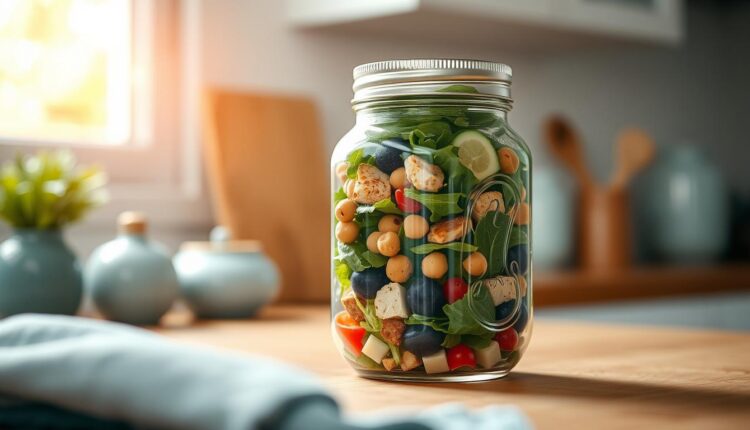Salad Jar Lunch Meal Prep Ideas That Stay Fresh
Master salad jar lunch meal prep with our step-by-step guide. Learn how to prep fresh, healthy salads in advance for a stress-free week.
What if your weekday lunches could stay crisp for days without a soggy mess? As someone who’s accidentally created more than a few wilted disasters, I’ve perfected a method that keeps every bite fresh—even on Friday.
The secret lies in how you stack your ingredients. Start with tangy lemon juice or zesty dressings at the base, then build upward with hearty proteins, crunchy veggies, and fluffy grains. This approach isn’t just practical—it’s a flavor-preserving science that works in any wide-mouth container. Below, I’ll share my favorite combinations (tested on picky eaters and rushed mornings) that turn chaotic weeks into organized wins.
- Master the dressing-first layering technique to prevent sogginess
- Discover flexible ingredient swaps for dietary needs
- Learn time-saving tricks from 12 years of trial-and-error
Salad Jar Lunch Meal Prep
Imagine opening your fridge to find vibrant, crunchy veggies and tender grains waiting in perfect harmony. This isn’t magic—it’s strategic stacking. By building your dish like a flavor fortress, you create meals that stay lively all week.
What is the Concept and Benefits?
Think of your container as a freshness time capsule. Start with zesty citrus or vinaigrettes at the base, followed by proteins like shredded chicken or chickpeas. Grains and sturdy vegetables form the middle layer, while delicate greens crown the top. This order acts like armor against wilting.
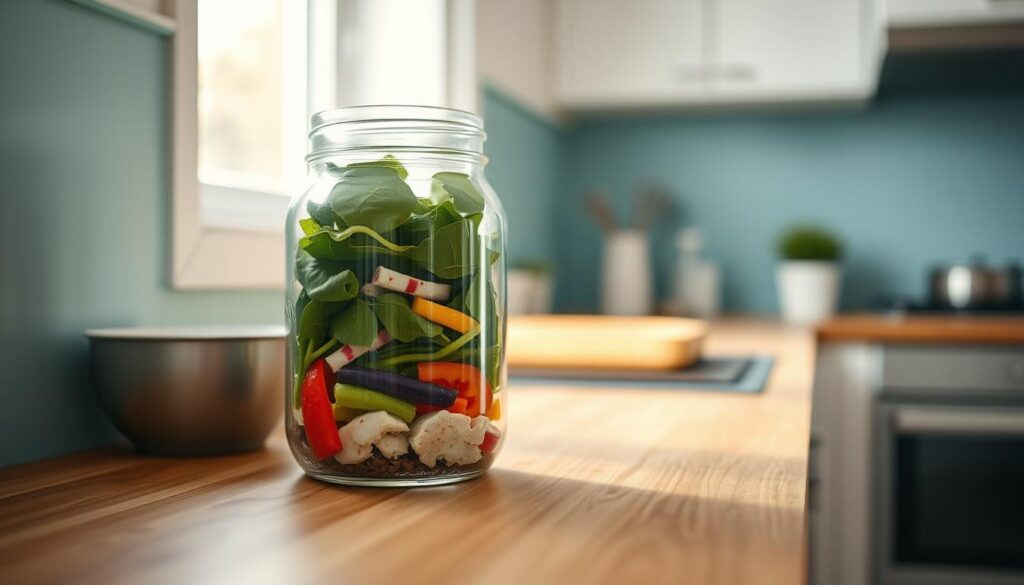
| Layer Position | Ingredients | Purpose |
|---|---|---|
| Bottom | Dressings, proteins | Prevents sogginess |
| Middle | Grains, crunchy veggies | Creates moisture barrier |
| Top | Greens, nuts, seeds | Preserves texture |
Strategically stacked salads can stay fresh and crisp all week, ensuring hassle-free lunches even on Friday.
Why Fresh, Layered Combinations Work Best
During my early days of recipe testing, I discovered roasted sweet potatoes and kale hold up better than watery tomatoes. Hearty components like quinoa absorb excess liquid while keeping other elements crisp. One reader shared her Greek-style creation stayed fresh for five days—proof this method delivers!
The real win? Shaking your jar before eating mixes flavors without manual tossing. As I often tell my cooking class students: “The right order keeps everything crisp—even my kids can’t tell it was made three days ago!”
Your Ultimate Guide to salad jar lunch meal prep
Ever felt frustrated by Friday’s limp greens or separated flavors? After twelve years of testing (and occasionally trashing) methods, I’ve cracked the code for vibrant weekday lunches that stay crisp until your last bite.
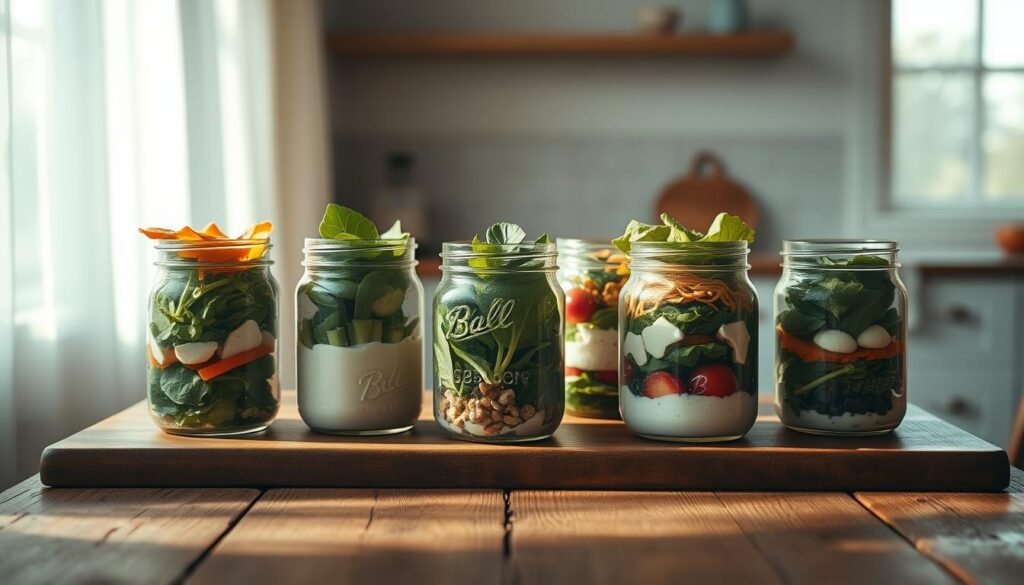
Choosing Your Flavor Vault
Not all containers are created equal. Opt for wide-mouth glass options—their smooth sides let you layer ingredients without squishing them. Chef Callie Renner swears by 32-ounce capacity: “It leaves room for shaking without overcrowding.”
Look for these features:
- 1.5-inch opening for easy utensil access
- Measurement markings to track portions
- 1-inch headspace at the top for mixing
The Science of Strategic Stacking
Start with 2 tablespoons of dressing—any more drowns the components. Add proteins like grilled chicken next, followed by grains that absorb excess moisture. Finish with delicate greens pressed gently against the lid.
| Layer | Portion | Function |
|---|---|---|
| Dressing | 2 tbsp | Flavor foundation |
| Proteins | ½ cup | Moisture barrier |
| Greens | 1.5 cups | Texture protector |
One client discovered swapping roasted chickpeas beneath quinoa instead of above kept her spinach perky for six days. As I tell my students: “The right order means Friday’s lunch tastes like Monday’s effort.”
Ingredient Selection and Nutritional Benefits
Building weekday meals that satisfy both taste buds and nutritional needs starts with smart shopping. Let’s explore how to choose components that stay crisp, fuel your day, and keep you energized through afternoon meetings or soccer practices.
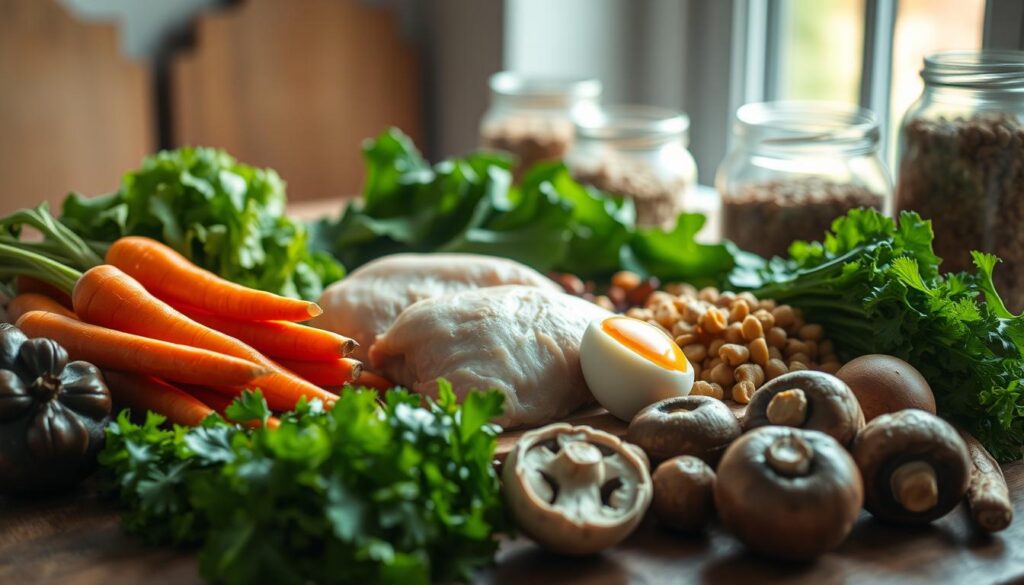
Choosing Hearty Vegetables and Proteins
Opt for veggies that laugh in the face of dressing. Bell peppers, shredded carrots, and roasted sweet potatoes hold their texture better than watery options like cucumbers. During my cooking demos, I always show how ½ cup of chickpeas adds 7g plant-based protein—and costs less than deli meat.
Proteins should multitask. Grilled chicken breast (3 oz = 26g protein) works for omnivores, while marinated tofu suits plant-based diets. A client once shared how swapping ground beef for lentils in her Tex-Mex blend saved 200 calories per serving without sacrificing flavor.
Incorporating Grains, Legumes, and Dairy Options
Whole grains like quinoa (¼ cup uncooked = 170 cals) create a filling base that absorbs excess moisture. Pair with ⅓ cup black beans for 5g fiber. “Adding feta was my game-changer,” a reader recently emailed. “Its tang cuts through earthy ingredients without overwhelming them.”
| Category | Portion | Key Benefit |
|---|---|---|
| Cheese | 2 tbsp crumbled | Adds calcium + flavor |
| Seeds | 1 tbsp | Healthy fats + crunch |
| Grains | ½ cup cooked | Sustained energy |
Sunflower seeds or pepitas add crunch without refrigeration worries. Remember: 1 cup total veggies + ¾ cup proteins/grains creates balanced portions. Your future self will thank you when 3 PM hunger strikes!
Using wide-mouth glass containers helps keep your ingredients organized and prevents sogginess. Avoid overcrowding.
Customizing Your Jar Salads for Optimal Flavor
Your kitchen becomes a flavor lab when you master the art of customization. Through years of recipe swaps with students, I’ve learned that personal touches transform routine dishes into crave-worthy favorites. Let’s explore how to make each layer sing with your unique taste.

Dressing Experiments That Delight
Swap basic vinaigrettes for zesty marinades. Try whisking orange zest into olive oil or blending tahini with smoked paprika. A client once transformed her usual ranch by adding fresh dill and capers—it became her coworkers’ lunchtime envy.
Bright acids work wonders. A squeeze of lemon over roasted vegetables or a dash of rice vinegar in dressings lifts earthy flavors. As I tell my cooking class: “Your liquid ingredients should make the other components shine, not drown them.”
Global Inspirations & Seasonal Swaps
Mediterranean twists bring sunshine to your container. Layer marinated artichokes with kalamata olives and crumbled feta. For summer, toss in fresh basil and juicy peaches. When autumn arrives, roasted squash and pomegranate seeds add festive crunch.
| Dressing Base | Flavor Boosters | Perfect Pairings |
|---|---|---|
| Lemon-Herb Vinaigrette | Oregano, garlic | Chickpeas, cucumbers |
| Balsamic Glaze | Rosemary, honey | Goat cheese, beets |
| Yogurt-Tahini | Cumin, mint | Roasted carrots, walnuts |
Always keep delicate greens at the top—they’ll stay perky until you’re ready to eat. One shake blends ingredients into a ready-to-enjoy masterpiece. Remember what I told a skeptical reader last week: “Your taste buds should guide each layer. There’s no wrong answer when you’re having fun!”
Overuse of dressing can lead to soggy ingredients, reducing the freshness and flavor of your salad jars.
Practical Meal Prep Tips and Storage Advice
Transform chaotic mornings into smooth routines with these kitchen-tested strategies. Whether you’re juggling work calls or school drop-offs, smart preparation turns hectic days into organized wins.
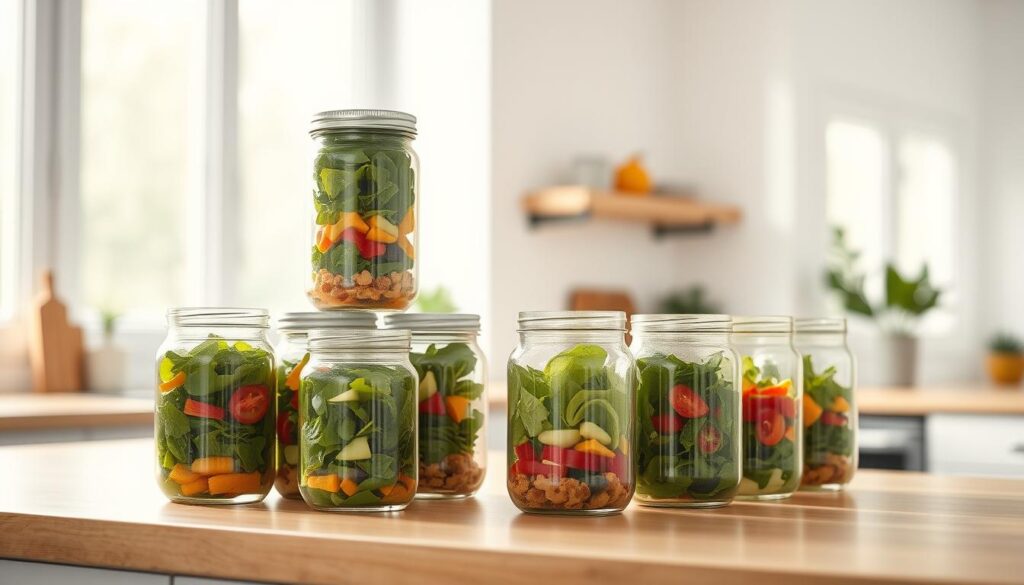
Time-Saving Shortcuts and Pre-Cooked Ingredients
Save time by batch-cooking grains and proteins every Sunday. Rotisserie chicken, canned beans, and pre-chopped veggies cut weekday prep to 20 minutes. One client shared how frozen quinoa became her secret weapon: “I microwave it while packing my bag—ready in 90 seconds!”
| Time-Saver | Traditional Method | Minutes Saved |
|---|---|---|
| Pre-cooked grains | Boiling from scratch | 25 |
| Bagged greens | Washing/spinning dry | 8 |
| Rotisserie chicken | Oven-roasting | 45 |
Best Practices for Storing Salad Jars Upright
Always position your creations vertically—this keeps the dressing stays at the bottom where it belongs. Tighten lids firmly, leaving ½ inch space at the top for shaking. A reader recently emailed: “Storing mine on the fridge door shelf stopped leaks better than lying flat.”
Set a 15-minute timer during assembly to avoid rushing. As I tell my students: “Proper storage means Friday’s creation tastes as vibrant as Monday’s masterpiece.”
| Storage Tip | Benefit | Max Freshness |
|---|---|---|
| Upright position | Prevents dressing seepage | 5 days |
| Airtight seal | Blocks fridge odors | 6 days |
| Consistent temperature | Reduces condensation | 7 days |
Not storing your salad jars upright may result in leaks, making the dressing seep into other layers.
Your future self will thank you when hunger strikes and a vibrant, ready-to-eat creation awaits. By mastering the art of strategic stacking—dressing at the base, proteins in the middle, greens at the top—you’ve unlocked meals that stay crisp through Thursday’s meetings. Whether you’re layering lemon-kissed chicken with quinoa or spicy black beans with roasted veggies, each shake transforms separate components into a cohesive masterpiece.
Trust the process I’ve refined through countless kitchen experiments: Wide-mouth mason jars truly make all the difference. One reader recently shared how swapping her plastic containers for glass extended her Greek-style blend’s freshness to six days. Remember, Sunday’s 20-minute prep session fuels your week with balanced portions—think ½ cup grains, 1 cup colorful vegetables, and a sprinkle of feta for creamy contrast.
Now’s your moment. Grab those chopped peppers, cooked beans, or toasted seeds waiting in your pantry. Screw on the lid, give it a confident shake, and savor that first crunchy bite. As I tell my cooking class students: “Your best lunches aren’t complicated—they’re just brilliantly organized.”
Layered Mediterranean Mason Jar Salad
A crisp, make-ahead salad that stays fresh for days with strategic layering of ingredients. Perfect for weekday lunches with vibrant flavors and textures.
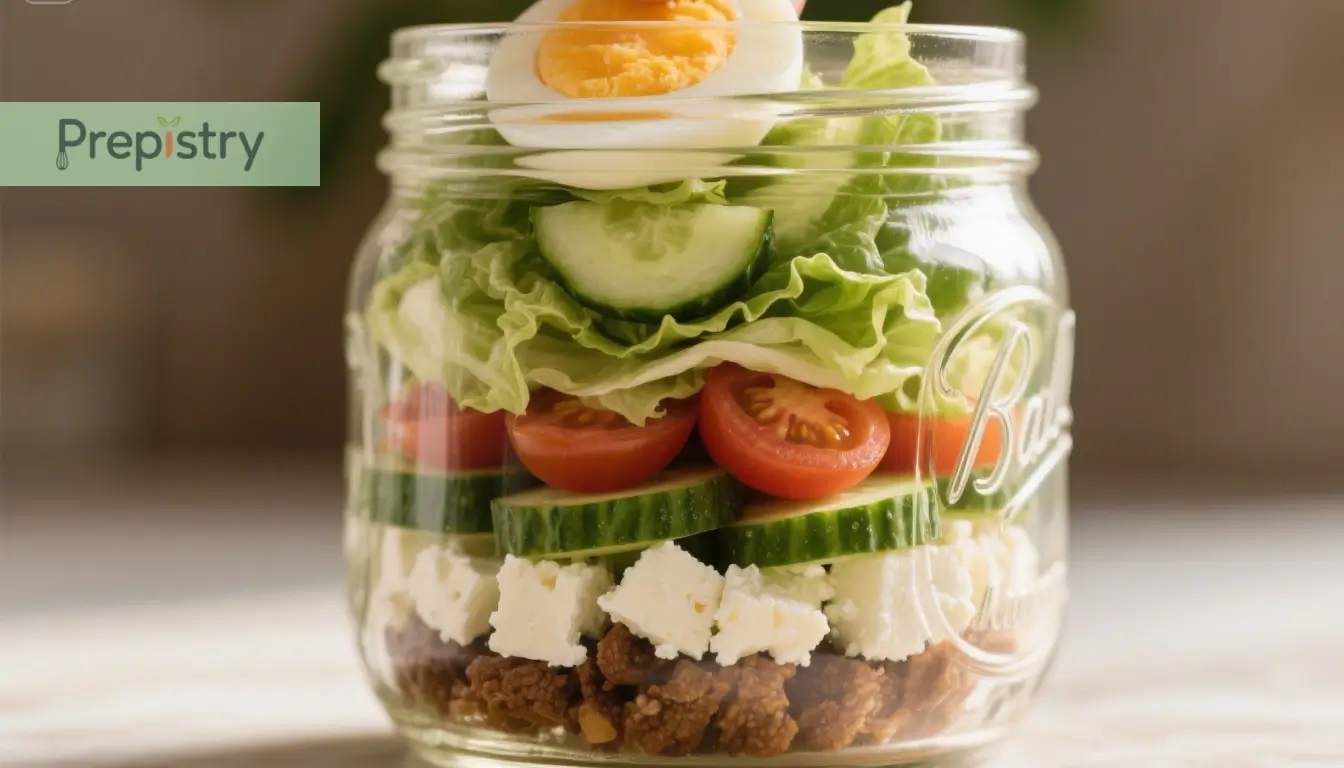
Nutrition Information
Equipment Needed
- 32-oz wide-mouth mason jar
- Measuring spoons
- Chopping board
Ingredients
-
2 tbsp lemon-tahini dressing
-
½ cup chickpeas (drained)
-
¼ cup crumbled feta cheese
-
½ cup cooked quinoa
-
¼ cup diced roasted red peppers
-
¼ cup sliced cucumbers
-
¼ cup cherry tomatoes (halved)
-
1 tbsp kalamata olives
-
1.5 cups baby spinach
-
1 tbsp toasted pine nuts
Instructions
Recipe Video
Healthy Layered Lunches (Mason Jar Salads)
Healthy Layered Lunches are mason jar salads that are strategically layered in order to keep your greens and dressing separated - ensuring a crisp (not soggy!) healthy lunch!

